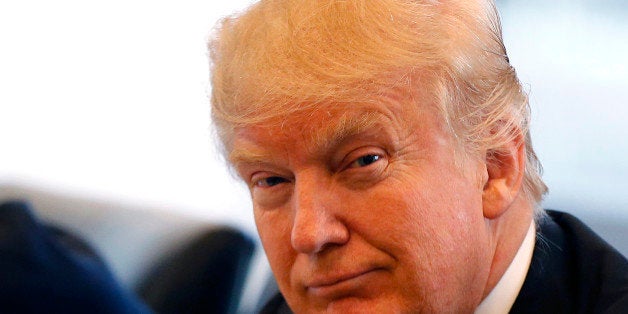
It's one of those days where you can freely pick your favorite movie metaphor to describe the news from the campaign of Donald Trump. "Nobody puts Baby in a corner," perhaps? Ben Shapiro, a former editor of none other than Breitbart News, was being interviewed on CNN where he came up with "a turd tornado." When asked, Shapiro helpfully defined the term: "Well, it's like a sharknado -- except with poop." I'm personally going to go with a favorite West Wing reference, one Trump himself actually seems comfortable with: Trump's campaign is now going to fully commit to "letting Trump be Trump." Because, obviously, the problem all along has been that Trump wasn't being Trump enough. Obviously.
For the past month or so, Donald Trump has been attempting to run some semblance of a realistic presidential campaign, based on the idea that he needed to "pivot" to the general election. This was a polite way of people telling Trump: "Don't say stupid things on a daily basis," in essence, and represented the Republican Party desperately trying to salvage Trump so they don't face a wipeout "wave" election this November. Trump, at the party's insistence, fired Corey Lewandowski and hired Paul Manafort to shepherd the campaign to a position where they might actually have a chance appealing to demographic groups beyond Trump's core of rabid supporters.
This effort is now apparently officially over. Manafort did have some degree of success in getting Trump to give a handful of scripted speeches (off a TelePrompTer, no less) designed to present him in a sane and reasonable light to the public. This "serious speeches" effort may also now be over, although Manafort has not actually been fired yet (just severely demoted), so maybe Trump will still occasionally deliver a few of these speeches in the coming weeks.
But it likely won't matter much one way or the other. Because one of the new people Trump is now going to rely upon to run his campaign is the executive chairman of Breitbart News, an organization even more conspiratorially-minded than Trump himself. Trump is doubling down on his strategy of giving huge rallies, firing his audience up, and then augmenting these by flooding cable news channels with his presence. Hey, it worked in the primaries, right?
The other new hire for Trump is a woman whose expertise lies in selling antediluvian Republican politicians (such as Todd Akin) to women voters. No, really -- that's her big qualification. Maybe her experience as a pollster will at least force Trump to face the dismal numbers he's been seeing, which could actually be a plus. But then again, maybe she's just going to tell Trump what he wants to hear, who knows?
Buried in all the other news about Trump's campaign shakeup was an interesting factoid. The Trump campaign is finally ready to engage in the battle for the airwaves. To date in the general campaign, Trump has spent zero (that's ZERO) dollars on advertising. Hillary Clinton has spent close to $60 million, for comparison. Team Trump, however, is now only going to concentrate on five states: Florida, North Carolina, Virginia, Pennsylvania, and Ohio.
Trump's initial strategy for which states to target was based on his own gut feelings, and was laughable in the extreme. Trump said he was going to fight for California, New York, and Washington state, because he considered them all winnable. After the riotous guffaws this announcement provoked died down, this was quickly dialed back to a strategy based (somewhat) on possible reality, where Trump was going to win the White House by winning the entire Rust Belt -- Pennsylvania, Ohio, Michigan, Wisconsin, and perhaps even Minnesota. These are all pretty deep blue states when it comes to presidential elections, and if Trump successfully flipped two or three of them he would indeed enormously improve his possible pathway to winning the Electoral College. Democrats even began to get a little nervous about these states, because Trump's core support looked a lot like the voting pool there (blue-collar workers, white men, etc.).
Donald Trump has not entirely given up on winning blue states that seem far out of reach for any Republican. He campaigned recently in Connecticut, spending time there he could have spent in a much more competitive state. But there are only so many days left until the election so every day spent in Connecticut (or any similar blue state) is a day Trump didn't spend in a true battleground state.
Still, it's interesting that Trump won't be playing offense in any state other than Pennsylvania and Virginia. Florida, Ohio, and North Carolina are all legitimate swing states and could go either way, making them obvious choices for television ads. But Pennsylvania and Virginia are now longshots for Trump, at best. Which makes the absence of the other longshots Trump was supposed to be targeting noticeable -- no ad money for Michigan or Wisconsin (or even Iowa) was announced.
Ad spending telegraphs a campaign's feelings about how well the candidate is doing. The basic rules state that money is best spent on swing states that are unpredictable but persuadable. Ad money is spent defensively in those states where your opponent is spending money, but which really should be in your column. Ad money is spent offensively in states you think you can poach away from your opponent. By this metric, Trump will be targeting (as expected) swing states Florida, Ohio, and North Carolina. Trump is on the offense in Pennsylvania and Virginia. Trump is not on the defense anywhere, really. But the absences are astonishing. Trump won't be spending any initial money in New Hampshire, Iowa, Colorado, or Nevada. All are normally seen as battleground states. Colorado and New Hampshire may be beyond Trump's reach at this point, but Iowa and Nevada are still close enough to be considered tossups. The only good news from the traditional battleground map for Trump is that to date Missouri seems pretty firmly in his column, meaning spending money there would only be defensive (in response to a Clinton ad blitz there, perhaps).
Hillary Clinton, on the other hand, has been advertising in swing states, but is now pulling ad money out of Virginia, Colorado, and even Pennsylvania -- because she thinks she's got them locked up for now (ad money may be spent there later, though). While not actually up on the airwaves there with ads yet, Team Clinton has also been putting some resources into states once considered Republican strongholds -- Georgia, Arizona, and even (are you sitting down?) Utah. South Carolina is even looking pretty weak, so Hillary may consider expanding there, too. All the while, Clinton's campaign has not had to spend any money on defense, because Trump has not run any ads yet anywhere.
The Trump campaign is now signaling that he really only has one path to victory, and it involves winning either Pennsylvania or Virginia. The Electoral College votes just don't add up to 270 for Trump without at least one of those two states in his column. Even if Trump won Nevada, Arizona, Iowa, Ohio, and Florida, it wouldn't put him over the top without either Pennsylvania or Virginia.
Trump's new strategy will be to unleash his inner Trump on the five states he's now targeting. He'll hold monster rallies, whip up the crowds, and then phone in interviews on all the cable shows afterwards. His closest campaign confidant will be a man prone to promoting rightwing conspiracy theories. All that talk of "pivots" will cease. Trump is who Trump is (as he himself recently put it), and so his campaign will now center around "letting Trump be Trump."
After all, what could possibly go wrong with that strategy?
Chris Weigant blogs at:
Follow Chris on Twitter: @ChrisWeigant
